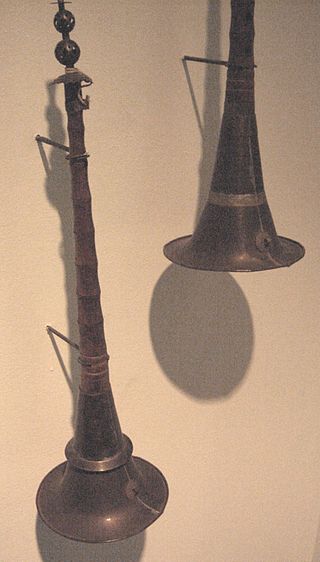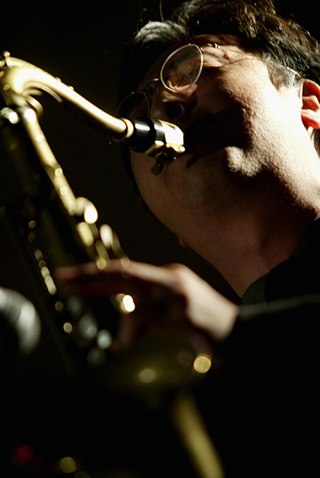The music of Haiti combines a wide range of influences drawn from the many people who have settled on this Caribbean island. It reflects French, African rhythms, Spanish elements and others who have inhabited the island of Hispaniola and minor native Taino influences. Styles of music unique to the nation of Haiti include music derived from rara parading music, twoubadou ballads, mini-jazz rock bands, rasin movement, hip hop Creòle, the wildly popular compas, and méringue as its basic rhythm. Haitian music is influenced mostly by European colonial ties and African migration. In the case of European colonization, musical influence has derived primarily from the French.
The music of Guadeloupe encompasses a large popular music industry, which gained in international renown after the success of zouk music in the later 20th century. Zouk's popularity was particularly intense in France, where the genre became an important symbol of identity for Guadeloupe and Martinique. Zouk's origins are in the folk music of Guadeloupe and Martinique, especially Guadeloupan gwo ka and Martinican chouval bwa, and the pan-Caribbean calypso tradition.

The music of China consists of many distinct traditions, often specifically originating with one of the country's various ethnic groups. It is produced within and without the country, involving either people of Chinese origin, the use of traditional Chinese instruments, Chinese music theory, or the languages of China. It includes traditional classical forms and indigenous folk music, as well as recorded popular music and forms inspired by Western culture.

The zurna is a double reed wind instrument played in central Eurasia, West Asia, Sri Lanka and parts of North Africa. It is usually accompanied by a davul in Armenian, Anatolian and Assyrian folk music.

Suona, also called dida, laba or haidi, is a traditional double-reeded Chinese musical instrument. The Suona's basic design originated in ancient Iran, then called "Sorna". Suona appeared in China around the 3rd century. It had a distinctively loud and high-pitched sound, and was used frequently in Chinese traditional music ensembles, particularly in those that perform outdoors. It was an important instrument in the folk music of northern China, particularly in provinces of Shandong and Henan, where it has long been used for festival and military purposes. It is still being used, in combination with sheng mouth organs, gongs, drums, and sometimes other instruments in weddings and funeral processions. Such wind and percussion ensembles are called chuida or guchui. Stephen Jones has written extensively on its use in ritual music of Shanxi. It was also common in the ritual music of Southeast China. In Taiwan, it was an essential element of ritual music that accompanied Daoist performances of both auspicious and inauspicious rites, i.e., those for both the living and the dead. One of the most famous piece that uses suona as the leading instrument is called "Bai Niao Chao Feng", or "Hundred Birds Worship the Phoenix". The movie Song of the Phoenix casts the rise and fall of the popularity of suona in modern Chinese musical history.

The term Chinese orchestra is most commonly used to refer to the modern Chinese orchestra that is found in China and various overseas Chinese communities. This modern Chinese orchestra first developed out of Jiangnan sizhu ensemble in the 1920s into a form that is based on the structure and principles of a Western symphony orchestra but using Chinese instruments. The orchestra is divided into four sections – wind, plucked strings, bowed strings, and percussion, and usually performs modernized traditional music called guoyue. The orchestra may be referred to as Minzu Yuetuan or Minyuetuan in mainland China, Chung Ngok Tuen in Hong Kong, Huayuetuan in Southeast Asia, or Guoyuetuan in Taiwan, all meaning Chinese orchestra.
The term conga refers to the music groups within Cuban comparsas and the music they play. Comparsas are large ensembles of musicians, singers and dancers with a specific costume and choreography which perform in the street carnivals of Santiago de Cuba and Havana.

Gansu is a region in northwest China. The capital is Lanzhou, a city with a vibrant musical life, including many nightclubs. The daoqing folk tradition is an important part of the music of Gansu, especially in Huanxian; daoqing is also found in Yichi in Ningxia and Dingbian in Shaanxi. Daoqing is used to accompany shadow play theater.
Ethno jazz, also known as world jazz, is a subgenre of jazz and world music, developed internationally in the 1950s and '60s and broadly characterized by a combination of traditional jazz and non-Western musical elements. Though occasionally equaled to or considered the successor of world music, an independent meaning of ethno jazz emerged around 1990 through the commercial success of ethnic music via globalization, which especially observed a Western focus on Asian musical interpretations. The origin of ethno jazz has widely been credited to saxophonist John Coltrane.

The taepyeongso is a Korean double reed wind instrument in the shawm or oboe family, probably descended from the Persian sorna and closely related to the Chinese suona. It has a conical wooden body made from yuja (citron), daechu (jujube), or yellow mulberry wood, with a metal mouthpiece and cup-shaped metal bell. It originated during the Goryeo period (918–1392).

Liu Yuan is a Chinese musician, who plays tenor and baritone saxophone as well as the Chinese wind instrument called suona. He is recognized as one of the two most prominent jazz musicians in China, the other being the saxophonist Du Yinjiao.
The guan is a Chinese double reed wind instrument. The northern Chinese version is called guanzi or bili and the Cantonese version is called houguan. It is classified as a bamboo instrument in the Ba Yin system. Unlike other instruments in the double-reed family of woodwinds which mostly have conical bores, such as the Chinese suona or the Western oboe, the guan has a cylindrical bore, giving its distinctive mellow, yet piercing buzz-like timbre.
Liu Qichao is a Chinese-born American musician. He graduated from the Shanghai Conservatory of Music. He now lives in Los Angeles.
Méringue, also called méringue lente or méringue de salon, is a dance music and national symbol in Haiti. It is a string-based style played on the lute, guitar, horn section, piano, and other string instruments unlike the accordion-based merengue, and is generally sung in Haitian Creole and French, as well as in English and Spanish.

The kèn bầu is one of several types of kèn, a double reed wind instrument used in the traditional music of Vietnam. It is similar in construction and sound to the Chinese suona and the Korean taepyeongso. It comes in various sizes and is a primary instrument of the music of the former royal court music of Huế.

The gyaling, literally "Chinese flute", is a traditional woodwind instrument used in Tibet. As its name indicates, it is the Chinese double reed Suona horn used mainly in Tibetan monasteries during puja and is associated with peaceful deities and the idea of devotion.

Jazz drumming is the art of playing percussion in jazz styles ranging from 1910s-style Dixieland jazz to 1970s-era jazz fusion and 1980s-era Latin jazz. The techniques and instrumentation of this type of performance have evolved over several periods, influenced by jazz at large and the individual drummers within it. Stylistically, this aspect of performance was shaped by its starting place, New Orleans, as well as numerous other regions of the world, including other parts of the United States, the Caribbean, and Africa.
Michael Sidney Timpson is an American composer of contemporary classical music.
Music of Canadian Cultures is a wide and diverse accumulation of music from many different individual communities all across Canada. With Canada being vast in size, the country throughout its history has had regional music scenes. The music of Canada has reflected the multi-cultural influences that have shaped the country. First Nations people, the French, the British, the United States and many others nationalities have all made unique contributions to the musical heritage of Canada








